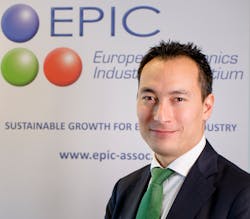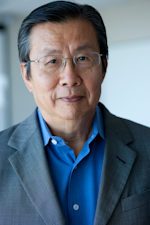
Here, I interview Carlos Lee, director general of the European Photonics Industry Consortium (EPIC), to broaden our understanding of what is going on in our field in Europe. Carlos has a BBA in Finance and an MBA in Leadership & Change Management from United Business Institutes. He lives with his spouse and three children in Belgium.
Carlos is knowledgeable about the semiconductor industry and industrial association activities, having worked at the international association SEMI, where he took on responsibility for standards, technical, and executive program advocacy for a more competitive semiconductor and photovoltaic manufacturing industry. He is now devoted to serving the members of EPIC and to promoting the European photonics industry.He invites you to contact him directly to continue the discussion: [email protected].
Milton Chang: How do you view the photonics industry in Europe?
Carlos Lee:I really enjoyed the 15 years I spent at SEMI because semiconductor is a pervasive, enabling technology. I was attracted by the photonics industry because, unlike semiconductors where the market has consolidated and the industry is pretty organized, photonics is also a pervasive and enabling technology—but it is an emerging industry characterized by 5000 companies in Europe, most of which are small and young and highly innovative. There are so many ideas and technologies in the pipeline that will enable applications still to be developed. I feel I am part of the growth of an amazing industry, which is embryonic, like semiconductors 40 years ago. The future will be driven by photonics!
MC: What does EPIC do for member companies?
CL: It helps companies seize opportunities in international markets and emerging applications. Last year, EPIC released several market and technology reports, organized many workshops to understand the needs of the customers, and launched several pavilions at exhibitions around the world, in India, China, and the United States.
On the research front, the European Commission just launched Horizon 2020, the biggest EU Research and Innovation program ever with nearly €80 billion of funding available over seven years. So I am working with our members to engage them in European funding opportunities.
It’s my job to work closely with members by maintaining a strong network and acting as a catalyst and facilitator for technological and commercial advancement to benefit Europe’s vibrant ecosystem.
MC: I am sure your feeling towards photonics is shared by government agencies. What kind of financial or resources support can companies get from government agencies beyond Horizon 2020?
CL: There are many funding opportunities at the regional/national/European level and EPIC works with PNO, a consulting firm with expertise in funding and innovation, to engage our members. It’s hard for small companies to keep track of the many opportunities, so we are organizing several EU funding information sessions throughout the year to keep our companies informed. Some countries are better supported than others; some regions such as Wales, Berlin, and Provence-Alpes-Côte d’Azur have chosen photonics as a priority for smart specialization and to differentiate themselves from other regions.
MC: How does the European public view entrepreneurship?
CL: There is a stigma about entrepreneurship and a negative perception about the hurdles companies face in Europe. I have a different perception since I visit about 50 companies every year and meet many dynamic, bright young entrepreneurs. Silicon Valley still has an aura and attraction, but I see a lot happening in Finland, Berlin, Barcelona, and Lithuania. There are many spinoffs from university and research centers. Look at the recent acquisitions by Huawei of Caliopa in Belgium and CIP in the UK. And Finisar just acquired u2t, a spin-off from the Fraunhofer Heinrich Hertz Institute. This continent is very exciting in terms of innovation, with world-leading research centers all across Europe like ACREO in Sweden, CSEM in Switzerland, VTT in Finland, CEALETI in France, and INTEC in Belgium. I am convinced that as we spotlight and communicate the many success stories of Europe, we will create a positive spin that will trigger and motivate even more successful businesses to start.
MC: Any other success stories?
CL: I’ve met several stimulating and lively companies like VLC in Spain, NOVAE in France, and Pie Photonics in Ireland, but they are still young. Avantes, based in The Netherlands, started 20 years ago, and today they are the second largest supplier worldwide in miniaturized fiber-coupled spectrometers.
MC: Your EPIC Phoenix award is interesting. Tell us about that.
CL: The EPIC Phoenix award was established to recognize and appreciate the harsh reality of leading a start-up. Advanced Fibreoptic Engineering from the UK is last year’s recipient. The company was founded in 1994 and closed down during the burst of the telecom bubble. Today, the business is in its 9th year of profitable trading and has grown steadily after a management buyout. They were recently awarded an “Outstanding Supplier” award from Fluke Networks out of a supply base of 2500 suppliers! Isn’t that a rise-from-the-ashes success story?!
MC: In your view, which areas of photonics are being emphasized in Europe or should be emphasized?
CL: There are several buzzwords in Europe and around the world such as 3D printing and silicon photonics, but Europe should build on its strengths and further exploit markets such as life science, advanced manufacturing, aerospace, security, and defense, and focus on Europe’s priorities such as environmental monitoring, issues related to an aging society, transport, and agriculture. There is a general desire to re-industrialize Europe; I think that having foundries to allow small volume but scalable manufacturing is important, and regional development funds should be used for that purpose as well.
MC: How competitive are European companies in the world market?
CL: The world is seen more as an opportunity than a threat. In a recent survey we did, it was confirmed that most of the production by European companies is exported. I think that companies in photonics in Europe feel good because we have a complete ecosystem encompassing leading technology, manufacturing capability, excellent research, very competent staff, a powerful network of associations, events, and market data. We have all the ingredients for a powerful ecosystem. European companies are increasing their presence around the world, and Europe has the interest of many global corporations. JDSU just acquired Time-Bandwidth Products in Switzerland.
MC: With the high level of unemployment in Europe, are young people taking a greater interest in photonics?
CL: They should! 71% of students in photonics find a job within a year and the photonics industry will continue to create jobs at a high rate.
MC: UNESCO designated 2015 as the Year of Light. What is EPIC’s participation or how are you taking advantage of it to promote photonics?
CL: This is a unique opportunity for the photonics industry worldwide to reach out to the public at large (teachers, politicians, investors, etc.) to inform them about photonics. I wish that in a decade people will recognize “photonics” as today they recognize “electronics.” EPIC, of course, fully endorses the initiative, but we need to plan long-term and this is why I propose that we establish October 21st as the international day of photonics. Why that date? Because on October 21, 1983, the General Conference of Weights and Measures adopted the value of 299,792.458 km/s for speed of light. A ‘Day of Photonics’ is an opportunity for clusters, companies, schools, and all stakeholders to reach out to their communities and talk about what photonics is and why it is so important.

Milton Chang
MILTON CHANG of Incubic Management was president of Newport and New Focus. He is currently director of mBio Diagnostics and Aurrion; a trustee of Caltech; a member of the SEC Advisory Committee on Small and Emerging Companies; and serves on advisory boards and mentors entrepreneurs. Chang is a Fellow of IEEE, OSA, and LIA. Direct your business, management, and career questions to him at [email protected], and check out his book Toward Entrepreneurship at www.miltonchang.com.